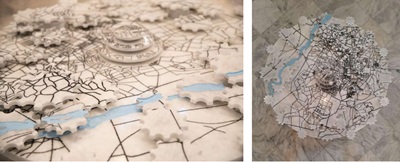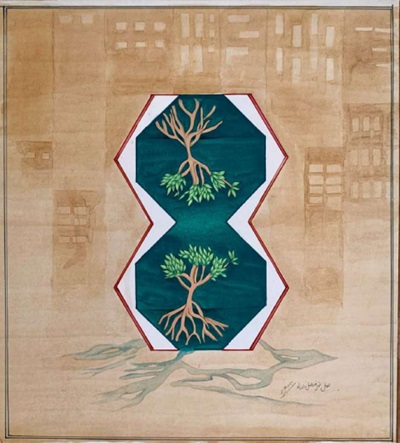Written by: Adeena Naeem
Posted on: October 11, 2024 |  | 中文
| 中文
Home is a Mirage by Natasha Malik
In these current times, the pursuit for knowledge and cultural heritage assumes paramount importance. For this quest, a remarkable gathering of visionary artists converged at Lahore's Barkat Ali Hall for the Knowledge of the Ancients exhibition, delving into the rich tapestry of tradition and its enduring influence on modern life. We engage with their stories and artworks, witnessing the intricate dance between past and present, as they reimagine cultural narratives.
Anushka Rustomji's Ready-made Ruin II gives us a hint of her love for nature, mainly animals. She used chalk to create a refined mural of fish on the floor. The title itself is a reminder of how temporary the artwork is, like it was made for it to be destroyed like our world, losing its pristine charm. While keeping its short-lived nature in mind, the painting’s beauty and detailing has referenced ancient motifs, which in turn represent abundance, fertility and spiritual growth. The work, though fragile and vulnerable to remove or eradicate, becomes a powerful reminder of the human creation and the power of art to rise above time itself.
This artwork repurposes Deodar Wood, mixing it with ancient religious mythology with modern representations. The artist's use of distinctive colours which were achieved through oils, acrylics, gold leaf, and brass, makes us revisits the wood's natural beauty. This mixed-media masterpiece puts together references from ancient religions and their respective mythology while explaining the stages of human beliefs. References of the old deities really represented how the world has truly evolved.
Artist's recycling of discarded wood symbolizes bridges between past and present. The complex details and references invite the audience to contemplate influence of ancient cultures on modern minds.
Farida Batool's Healing Garden is a wonderful work of art that represents her family's legacy. It also shows us the ancient traditions of native medicinal plants. Three detailed printed glass panels, set specifically to create an astonishing effect, reveal the stages of knowledge and wisdom which was passed down through generations. Healing Garden signifies the enduring power of traditional healing practices while presenting the significance of hereditary legacy and cultural heritage. The work also brings to mind the bridges between nature, community, and personal well-being. Healing Garden strongly reminds us that of our roots influence our growth.
Farida Batool's video loop, Hakeem ki Beti offers an intimate insight into the practice of healing through massages. This short documentary greatly captures a traditional therapeutic method where skilled practitioners employ specific movements and touch to ease down physical and mental stress. By this work, Farida Batool beautifully reveals the transmission of traditional knowledge through different generations, celebrating benefits of native healing practices and showcasing the sacred connection between healer and patient.
By sharing her family's legacy, Batool's video serves as a symbol to the enduring strength of ancient knowledge, passed down through generations. Hakeem ki Beti becomes a story of love, healing and cultural heritage, inviting people who are watching it to appreciate the priceless value of traditional knowledge.
Bibi Hajra's Carcass I & II is a well detailed piece of art that attracts your attention the second you set your eyes on it. This work redefines religious culture and history with a modern hint. Executed in charcoal, gouache and pink powder on archival paper, this relaxing artwork combines different narratives, making you unable to grasp it even after hours of contemplation.
The artwork juxtaposes structure and chaos, seamlessly displaying iconic Islamic and other biblical references. Hajra's skill is evident in the expressive charcoal smudges, delicate gouache details and subtle pink colours that balance what’s complex with clarity and vagueness. This work's pleasure of different elements invites the people who’re looking at it to take another look at the connection of history, femininity and also mortality.
Natasha Malik's Witness (Erosion of Meaning) , explores how fragile human connections are. She uses watercolour and pastel on paper. Malik creates transitory, unimaginable work which shows a disassociation and disconnection. Faded, whispery colours suggest the complete removal of meaning and memory, while fragmentations and subtle layering represents the fragility of human relationships.
Through her great use of watercolour and pastel, Malik achieves a soft, delicate atmosphere. Her way of layering and blending creates depth and vulnerability. Ultimately, Witness (Erosion of Meaning) is an absolutely beautiful reflection on a person’s existence, human connections and the need for meaning in an ever-changing world.
Natasha Malik's captivating artwork, Home is a Mirage, explores the elusive nature of belonging and identity. Using muted shades of watercolour and pastel on paper, Malik creates a dreamlike atmosphere, unveiling longing and sadness. Her work represents the imagined promise of a stable homeland. The light, fading colours may also suggest the deficiency of physical and emotional dependence. Distorted forms and blurred boundaries convey the confusion of displacement.
Malik's work invites the audience to think about the complex nature of home and belonging. It possesses great questions: What even is home? Is it a physical space, a memory, or an illusion? The artwork highlights the need for belonging and connection. Home is a Mirage is a reflection on how weak a human identity is.
Saba Qizlibash's Prince Gholam Mahomed - Calcutta to Southampton is a graphite drawing that goes back to Tipu Sultan's last surviving son's 1854 journey from Calcutta to England. This detailed work on drafting film invites contemplation on colonialism's difficulties and cultural displacement. She effortlessly brings nostalgia and longing through her linework and shading.
The drawing references Tipu's Tiger, an automaton looted from the prince's childhood palace, underscoring colonialism's brutal removal of cultural heritage. Prince Gholam Mahomed's mission to appeal for restoration of his family's pension showcases a strong reminder of what colonial exploitation is.
Risham Syed's Khayalmala project is a digital archive respecting her mother, Samina Hasan Syed's (1944-2016), legacy as a well-known classical singer and an educator. It preserves Samina's detailed documentation of lessons and concerts under Ustad Chhotay Ghulam Ali Khan of Qawwal Bacha Gharana.
A rare 1985 video footage on display captures Ustad Chhotay Ghulam Ali Khan's saddening performance perfectly and conversation with Samina Amin at Lok Virsa, Islamabad, accompanied by his students Samina Hasan Syed and Sarah Zaman.
Risham Syed's Khayalmala project ensures Samina Hasan Syed's legacy continues to inspire the upcoming generations of musicians and people who appreciate music.
This video explores cultural heritage, generational skills and mere human experience through an old driver's narration in the background, and about learning native handloom chair-weaving. The artwork represents oral traditions, honours elder wisdom and showcases the values craftsmanship.
The storytelling in the background and weaving of the chair in the video, creates a serene environment for the audience. Russel and Lee show us the significance of continuity of traditions and transfer of intergenerational knowledge. This piece’s tactile, meditative quality highlights the significance of conserving ancient methods in modern times.
Memoona Riaz's In Roads and Inwards is a mentally provoking mixed media piece of art that further explores the connections between identity, geography and introspection. She uses enamel paint on Ziarat white marble. Even the contrast between industrial and natural materials represents the bridge between tradition and modernity. This work makes us delve into the idea of paths, both physical and metaphorical, that effect and also shape our lives.
Samar F. Zia's thought-provoking works - Urban Kaleidoscope, Mausami Mansubabandi, and Land Map vs. Water Memory - examine the delicate connection between urbanization, nature and memory. Samar uses traditional Wasli paper and combines gouache with tea stains, Zia's unique method achieves delicacy, layered textures and a subtle yet expressive colour palette. This blend of different mediums creates a wonderful miniature work that questions the boundaries between human constructs and what natural processes are.
Wardha Shabbir's Savannah of the City is a blend of mixed media that respectfully connects natural composure. Executed well with vibrant gouache on acid-free paper, this piece radiates warmth and energy. The colour palette is equally remarkable, with the use of bright yellow induces feelings of sunshine and life, and different shades of greens symbolize growth and renewal. These colours beautifully convey the adaptability of nature.
Sohail Zuberi's The Beach as Archive is an eye-catching exhibition. It gives a greater look at the complicated relationship between humans, the ocean and land. Drawing from 15 years of deep research, Zuberi shows us objects found on Karachi's Sahil beach, discovering coastal dynamics, maritime history and other ecological changes.
This exhibit features a range of many thought-provoking works, including Aristotle's Lantern (2022), which uses sea urchins to symbolize strength. Other notable works also includes Gastropod marine fossil from Sonda, Man v Nature. Triptych, a series of photo transfers on canvas representing different and vibrant colours of nature, and Treasure Chest, a glass box filled with over 2000 cowries collected from 2010-2022. Through reclaimed objects, Zuberi reveals the ocean's significance in shaping human experiences, myth and memory.
Furthermore, Knowledge of the Ancients exhibition is a powerful testament to the influence of tradition on contemporary art. This exhibition brings light to the timeless wisdom that comes from the joining of past and present. It inspires us to enjoy the beauty of who we are while embracing our cultural inheritance.

Treasure Chest by Sohail Zuberi

In Roads and Inwards by Memoona Riaz

Mausami Mansubabandi by Samar F. Zia
You may also like: